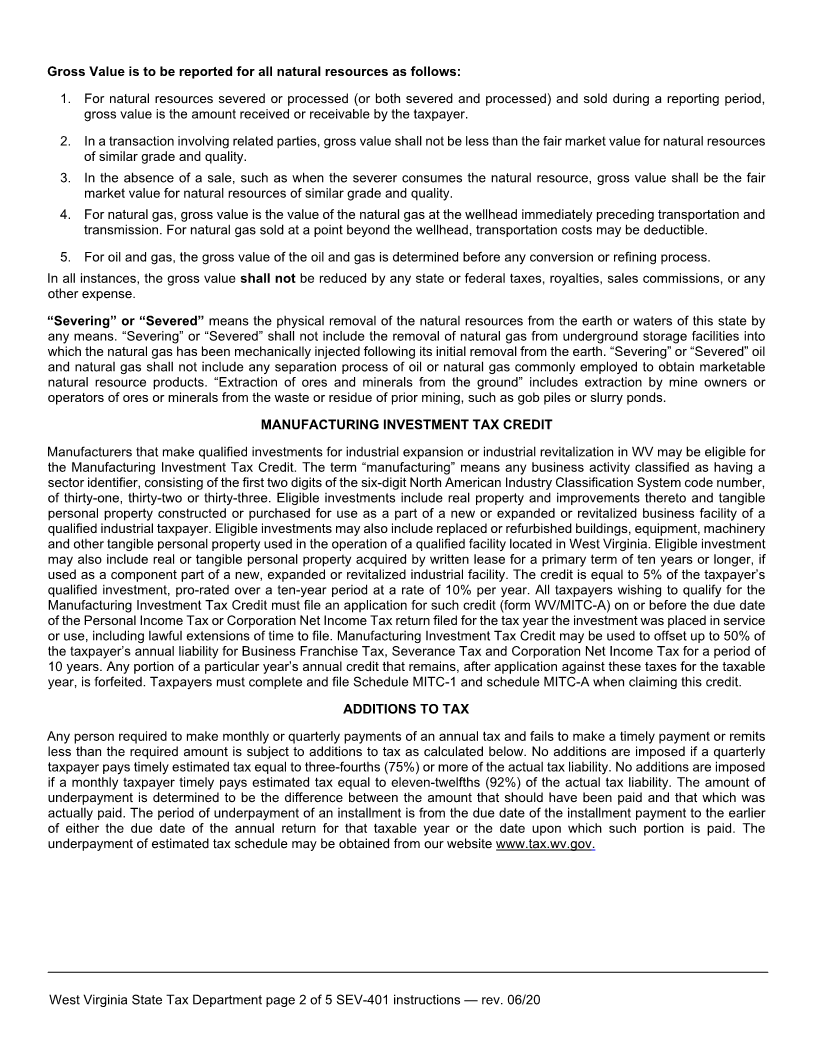
Enlarge image
Form SEV-401
West Virginia Annual Severance Tax Return
Instructions
PLEASE NOTE: THESE INSTRUCTIONS ARE TO ASSIST YOU IN THE PREPARATION OF THE TAX
RETURN. THEY ARE NOT A SUBSTITUTE FOR TAX LAW AND REGULATIONS.
The West Virginia Severance Tax is imposed on the privilege of engaging in or continuing, within West Virginia, the activity
of severing, extracting, reducing to possession and producing for sale, profit or commercial use, any natural resource
product or products. The amount of tax is determined by the application of a tax rate, to the gross value of each of the
natural resource classifications.
Accounting Periods and Methods of Accounting: The taxable year and method of accounting are the same as
that used for federal tax purposes.
Due Date: The annual tax return is due on or before the expiration of one (1) month after the end of the taxable
year. The filing of this return is required whether or not any tax is due. If you are no longer in business, you must
file a final annual return through the last date of business.
Extension of Time to File: The Tax Commissioner may, upon written request received on or before the due date
of the return, grant a reasonable extension of time for filing the tax return, if good cause satisfactory to the tax
Commissioner is provided. An extension of time to file does not extend the time to pay taxes.
Annual Credit: Every taxpayer is allowed an annual credit of five hundred dollars ($500.00) against the tax due.
The annual credit is applied at the rate of forty-one dollars and sixty-seven cents ($41.67) per month for each month
engaged in the business activity within the reporting period. Only one $500.00 credit may be claimed by each
business entity, not to exceed $500.00. This credit can only be used to reduce tax liability. This is not a refundable
credit.
Periodic Installment Payments: If the estimated tax liability exceeds one thousand dollars ($1,000.00) per month,
the tax is due on or before the last day of the month following the month in which the severance activity took place,
except the installment for May, which is due on or before the fifteenth of June each year. If the estimated liability
is less than one thousand dollars ($1,000.00), but more than fifty dollars ($50.00) per month for all classifications,
except coal, the tax is due in quarterly installments on or before the last day of the month following the quarter in
which the severance activity took place. No installment payments are required if the annual remittance is less than
$600.
Required Schedules: All schedules must be completed in order to file the returns. Taxpayers reporting
more than ten (10) wells, on any schedule, should file electronically at www.mytaxes.wv.tax.gov
Completion, Signatures, and Dates: All applicable sections of the tax return must be completed. All substantiating
documents must be provided on removable media (CD or flash drive,). The severance tax return of a corporation
must be signed and dated by the president, vice president, treasurer, assistant treasurer, chief accounting officer,
or any other officer authorized to act on behalf of the corporation. The severance tax return of a partnership must
be signed and dated by one of the partners. An individual’s name signed on the return is prima facie evidence that
the individual is authorized to sign the return. For additional information, please contact the
West Virginia State Tax Department
Taxpayer Services Division
PO Box 3784
Charleston, WV 25337-3784
(304) 558-3333 or toll free 1-800-982-8297 or visit www.tax.wv.gov
Producers of natural resources are subject to the Severance Tax. Various rates are applied to the gross value of the
resources. This return covers all natural resource producers, except for coal production and processing, and waste coal.
“Gross value” in the case of natural resources, means the market value of the natural resource product, in the immediate
vicinity where severed, determined after application of postproduction processing, generally applied by the industry to obtain
commercially marketable or usable natural resource products.
West Virginia State Tax Department page 1 of 5 SEV-401 instructions — rev. 06/20



